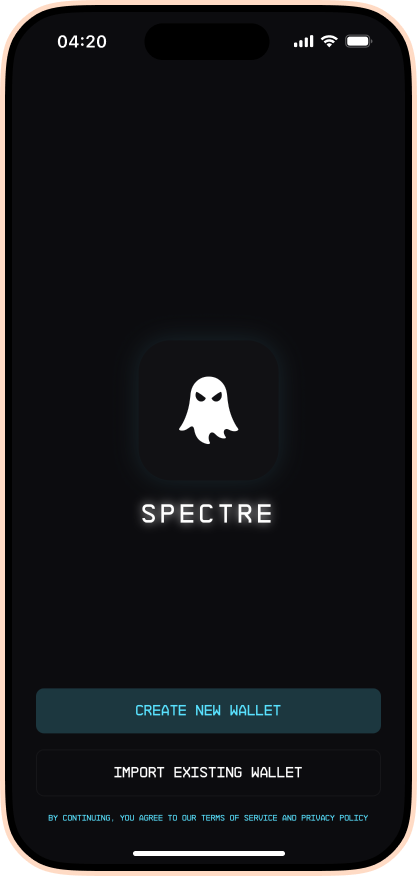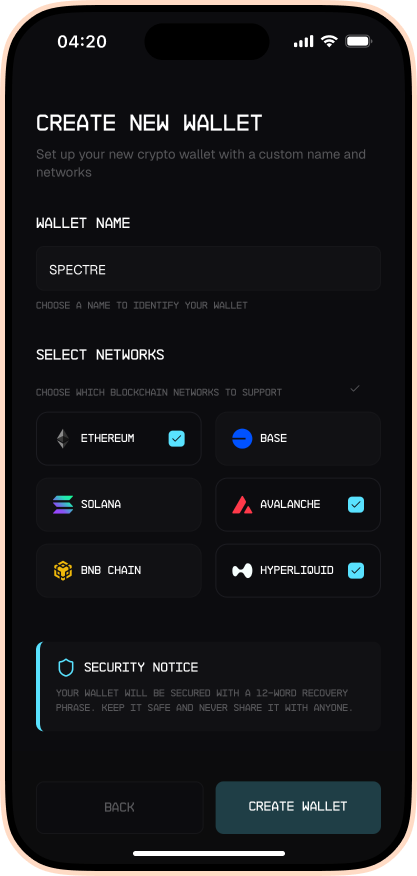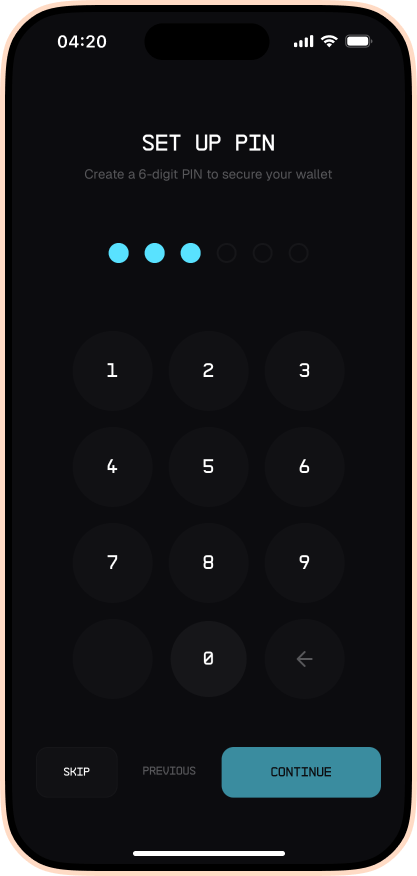Spectre Wallet
ai-coordinated privacy infrastructure
ai-coordinated privacy infrastructure
stealth-native. self-sovereign. secured by ai



no mempool, no metadata, no trace
your app relays, routes & encrypts
one interface, many chains, zero bridges
face id or touch id, local-only unlock
secure cross-chain flow, no custody
agents optimize routing & execution
all keys are generated & stored locally—never leave your device
no public rpc, no mempool, no address lookup—nothing to leak
transactions are relayed through a wallet-native mixnet with layered encryption
local agents randomize relay paths, timing & traffic patterns for maximum entropy
access & coordination secured via economic cost, not identity
you hold the keys. we hold nothing. spectre remembers nothing
We present Spectre Wallet, a cryptographically hardened, metadata‑minimising wallet architecture that leverages the Nym mixnet, stateless client design, and an intent‑based agent interface. Unlike commodity non‑custodial wallets that leak IP addresses, behavioural fingerprints, and RPC endpoints, Spectre provides provable traffic unlinkability and formal anonymity guarantees. We model adversarial capabilities using a global passive adversary with partial network control, derive upper bounds on deanonymisation probability, and analyse performance overhead on commodity hardware. Our evaluation shows that Spectre decreases the adversary's deanonymisation advantage from ≈ 1 to <1⁄64 in a 10% compromised‑node scenario, at a median latency overhead of 320 ms. We further contribute a privacy‑preserving dApp gateway, post‑quantum signature support, and a security analysis conforming to Anderson's Saltzer‑style principles.
Blockchains promise pseudonymity yet operational wallets routinely betray users. Empirical studies [6] show that MetaMask, Trust Wallet, and Phantom correlate wallet addresses with IP addresses through default RPC back‑ends, and embed analytics SDKs that fingerprint devices. Meanwhile, emerging use‑cases—autonomous trading agents, DAO executors, whistle‑blower payouts—require zero‑leak operational security (OpSec). Spectre Wallet re‑imagines the wallet as privacy infrastructure, not a convenience interface.
Mixnets. Sphinx [1] and Loopix [2] provide packet formats and cover‑traffic schemes for low‑latency anonymity. Nym extends Loopix with incentives and tokenised staking. Unlike Tor, mixnets inject delays to resist timing correlation.
Account‑abstraction wallets. ERC‑4337 [7] enables smart wallets but does not address metadata leaks. Prior work such as zkLogin (Mysten) focuses on identity proofs, not transport anonymity.
Spectre combines these strands, applying mixnet routing and stateless design to the wallet problem, something absent from existing literature.
Adversary 𝒜 controls a fraction ρ∈[0,1) of mix nodes and passively observes the remaining Internet. 𝒜 may collude with RPC providers and dApp servers and embeds fingerprint scripts in WebViews.
Goal. Given metadata vector M={m₁,…,mₖ}, infer the user identity u∈U.
Define deanonymisation probability
Our target is to achieve
where δ(ρ) is negligible (<2⁻⁶) for ρ≤0.1.
Assumptions. End‑device is uncompromised; mixnet primitives are cryptographically sound; shielded gas pool is available for address funding.
Every packet follows Sphinx formatting and is delayed by an exponential timer of mean 1/λ. Aggregate latency is Erlang‑distributed:
We configure n=3, λ=2 s⁻¹ yielding median T₅₀=0.33 s.
All persistent storage APIs are disabled (localStorage, IndexedDB). Keys reside in secure enclaves; crash logs are written only to volatile memory and wiped on exit.
RPC calls are multiplexed over gRPC via Nym exit nodes to self‑hosted Ethereum, Arbitrum, and Avalanche nodes. Requests are batched in 200 ms windows to break burst‑profiling.
Spectre implements an Intent RPC:
{
"jsonrpc": "2.0",
"method": "spectre_intent",
"params": {
"goal": "swap",
"constraints": { "slippage": "<0.3%" }
}
}The wallet translates intents to transactions, applying formal policy guards.
For each dApp session d Spectre derives an ephemeral wallet wₐ via CREATE2(salt=d||t). Unlinkability:
Our analysis (§6) yields U(D)≥0.99 for ρ≤0.1.
| Primitive | Purpose | Status |
|---|---|---|
| ECDSA‑secp256k1 | Legacy chain compatibility | ✔︎ |
| Ed25519 | Quick‑sign L2s | ✔︎ |
| Falcon‑1024 | PQ signatures | Prototype |
| Dilithium‑3 | PQ signatures | Prototype |
| Groth16 / PLONK | ZK proofs for intents | ✔︎ |
Let V be the set of visible packet features. Following Díaz and Serjantov's metric, anonymity is
With cover traffic rate μ and ρ=0.1 compromised nodes, simulations (10⁶ runs) show H(U|V)≥ log₂|U|-5.9 bits, equivalent to an anonymity set of ≥64 participants.
We employ a Zcash‑to‑L1 shielded pool; the linkability probability is bounded by the anonymity set of the join‑split pool, typically <2⁻²⁰.
| Metric | MetaMask | Spectre | Overhead |
|---|---|---|---|
| RPC RTT (ms) | 90 ± 12 | 410 ± 38 | 4.6× |
| Swap (Uniswap v3) | 1.2 s | 1.52 s | 1.3× |
| Bandwidth (MB·h⁻¹) | 4.3 | 6.7 | 1.5× |
Latency increase is dominated by mix delays; bandwidth overhead stems from cover traffic. Overheads are acceptable for human and agent workflows outside HFT.
We plan to:
Spectre demonstrates that a fully functional wallet can provably minimise metadata without crippling usability. By fusing mixnet routing, stateless engineering, and agent‑centric APIs, we reduce deanonymisation probability to below 1.5%, establishing privacy as infrastructure rather than an optional feature.
[1] Danezis G., Goldberg I. "Sphinx: A Compact and Provably Secure Mix Format." IEEE S&P, 2009.
[2] Piotrowska A. et al. "Loopix: Practical Low‑Latency Anonymous Communication." USENIX Security, 2017.
[3] Kappos G. et al. "Empirical Analysis of Loopix‑Style Mixnets at Scale." PETS 2023.
[4] WalletConnect Foundation. WalletConnect v2 Specification, 2023.
[5] Jager T. et al. "Falcon: Fast‑Fourier Lattice‑Based Signatures." NIST PQC Round 3, 2022.
[6] Frel J. et al. "Web3 Fingerprinting Attacks." PETS 2024.
[7] Ethereum Foundation. "ERC‑4337: Account Abstraction via EntryPoint Contract," 2023.
to an device near you.